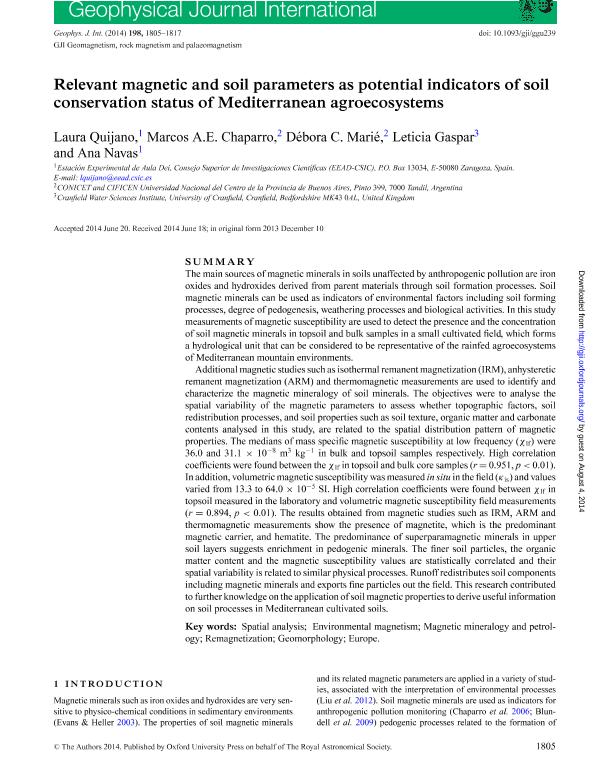Mostrar el registro sencillo del ítem
dc.contributor.author
Quijano, Laura
dc.contributor.author
Chaparro, Marcos Adrián Eduardo

dc.contributor.author
Marié, Débora Carolina
dc.contributor.author
Gaspar, Leticia
dc.contributor.author
Navas, Ana M.
dc.date.available
2016-03-03T15:36:14Z
dc.date.issued
2014-06
dc.identifier.citation
Quijano, Laura; Chaparro, Marcos Adrián Eduardo; Marié, Débora Carolina; Gaspar, Leticia; Navas, Ana M.; Relevant magnetic and soil parameters as potential indicators of the soil conservation status in Mediterranean agroecosystems; Wiley; Geophysical Journal International; 198; 3; 6-2014; 1805-1817
dc.identifier.issn
0956-540X
dc.identifier.uri
http://hdl.handle.net/11336/4600
dc.description.abstract
The main sources of magnetic minerals in soils unaffected by anthropogenic pollution are iron oxides and hydroxides derived from parent materials through soil formation processes. Soil magnetic minerals can be used as indicators of environmental factors including soil forming processes, degree of pedogenesis, weathering processes and biological activities. In this study measurements of magnetic susceptibility are used to detect the presence and the concentration of soil magnetic minerals in topsoil and bulk samples in a small cultivated field, which forms a hydrological unit that can be considered to be representative of the rainfed agroecosystems of Mediterranean mountain environments. Additional magnetic studies such as isothermal remanent magnetization (IRM), anhysteretic remanent magnetization (ARM) and thermomagnetic measurements are used to identify and characterize the magnetic mineralogy of soil minerals. The objectives were to analyze the spatial variability of the magnetic parameters to assess whether topographic factors, soil redistribution processes, and soil properties such as soil texture, organic matter and carbonate contents analysed in this study, are related to the spatial distribution pattern of magnetic properties. The medians of mass specific magnetic susceptibility at low frequency (Xlf) were 36.0 and 31.1 ×10-8 m3 kg-1 in bulk and topsoil samples respectively. High correlation coefficients were found between the Xlf in topsoil and bulk core samples (r = 0.951, p<0.01). In addition, volumetric magnetic susceptibility was measured in situ in the field (kis) and values varied from 13.3 to 64.0 ×10-5 SI. High correlation coefficients were found between Xlf in topsoil measured in the laboratory and volumetric magnetic susceptibility field measurements (r = 0.894, p<0.01). The results obtained from magnetic studies such as IRM, ARM and thermomagnetic measurements show the presence of magnetite, which is the predominant magnetic carrier, and hematite. The predominance of superparamagnetic (SP) minerals in upper soil layers suggests enrichment in pedogenic minerals. The finer soil particles, the organic matter content and the magnetic susceptibility values are statistically correlated and their spatial variability is related to similar physical processes. Runoff redistributes soil components including magnetic minerals and exports fine particles out the field. This research contributed to further knowledge on the application of soil magnetic properties to derive useful information on soil processes in Mediterranean cultivated soils.
dc.format
application/pdf
dc.language.iso
eng
dc.publisher
Wiley

dc.rights
info:eu-repo/semantics/openAccess
dc.rights.uri
https://creativecommons.org/licenses/by-nc-sa/2.5/ar/
dc.subject
Environmental Magnetism
dc.subject
Europe
dc.subject
Geomorphology
dc.subject
Magnetic Mineralogy And Petrology
dc.subject
Remagnetization
dc.subject
Spatial Analysis
dc.subject.classification
Ciencias Medioambientales

dc.subject.classification
Ciencias de la Tierra y relacionadas con el Medio Ambiente

dc.subject.classification
CIENCIAS NATURALES Y EXACTAS

dc.title
Relevant magnetic and soil parameters as potential indicators of the soil conservation status in Mediterranean agroecosystems
dc.type
info:eu-repo/semantics/article
dc.type
info:ar-repo/semantics/artículo
dc.type
info:eu-repo/semantics/publishedVersion
dc.date.updated
2016-03-30 10:35:44.97925-03
dc.journal.volume
198
dc.journal.number
3
dc.journal.pagination
1805-1817
dc.journal.pais
Estados Unidos

dc.journal.ciudad
Hoboken
dc.description.fil
Fil: Quijano, Laura. Consejo Superior de Investigaciones Científicas. Estacion Experimental de Aula Dei; España
dc.description.fil
Fil: Chaparro, Marcos Adrián Eduardo. Consejo Nacional de Investigaciones Científicas y Técnicas. Centro Científico Tecnológico Tandil. Centro de Investigaciones en Física e Ingeniería del Centro de la Provincia de Buenos Aires; Argentina
dc.description.fil
Fil: Marié, Débora Carolina. Consejo Nacional de Investigaciones Científicas y Técnicas. Centro Científico Tecnológico Tandil. Centro de Investigaciones en Física e Ingeniería del Centro de la Provincia de Buenos Aires; Argentina
dc.description.fil
Fil: Gaspar, Leticia. University of Cranfield. Cranfield Water Sciences Institute; Reino Unido
dc.description.fil
Fil: Navas, Ana M.. Consejo Superior de Investigaciones Científicas. Estacion Experimental de Aula Dei; España
dc.journal.title
Geophysical Journal International

dc.relation.alternativeid
info:eu-repo/semantics/altIdentifier/ark/http://dx.doi.org/10.1093/gji/ggu239
dc.relation.alternativeid
info:eu-repo/semantics/altIdentifier/issn/0956-540X
dc.relation.alternativeid
info:eu-repo/semantics/altIdentifier/url/http://gji.oxfordjournals.org/content/198/3/1805
Archivos asociados
